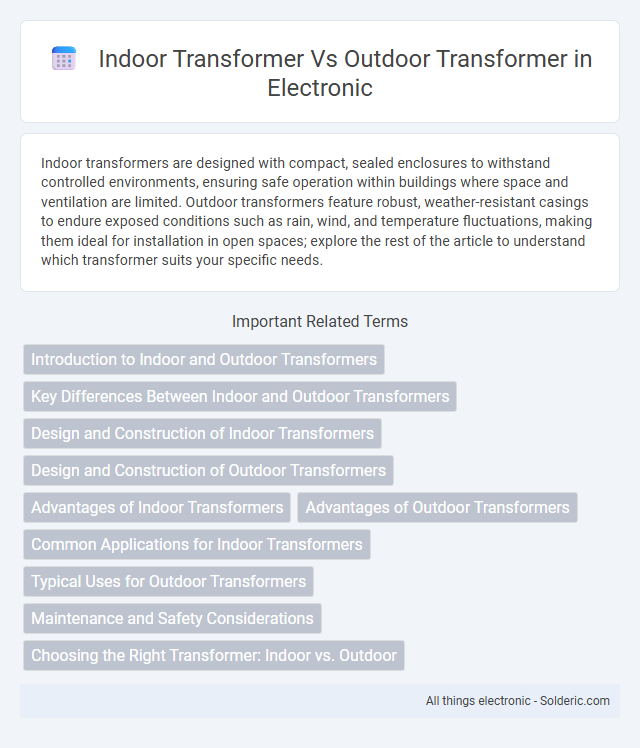Indoor transformers are designed with compact, sealed enclosures to withstand controlled environments, ensuring safe operation within buildings where space and ventilation are limited. Outdoor transformers feature robust, weather-resistant casings to endure exposed conditions such as rain, wind, and temperature fluctuations, making them ideal for installation in open spaces; explore the rest of the article to understand which transformer suits your specific needs.
Comparison Table
| Feature | Indoor Transformer | Outdoor Transformer |
|---|---|---|
| Installation Location | Inside buildings or enclosed spaces | Installed outdoors, exposed to weather |
| Enclosure Type | Sealed metal or fire-resistant cabinets | Weatherproof, corrosion-resistant enclosures |
| Cooling Method | Forced air, oil or dry-type cooling | Oil-immersed with radiators or air-cooled |
| Size & Weight | Compact, designed to fit limited indoor space | Larger, accommodates outdoor environment requirements |
| Protection Requirements | Fire safety, short-circuit protection inside facilities | Weatherproof, lightning, and impact resistance |
| Maintenance | Easier access for regular inspections | Requires specialized equipment for outdoor servicing |
| Common Applications | Commercial buildings, industrial plants, control rooms | Substations, street lighting, outdoor distribution networks |
| Cost | Generally lower due to smaller size and controlled environment | Higher due to robust design and environmental protections |
Introduction to Indoor and Outdoor Transformers
Indoor transformers are designed with compact, enclosed construction to fit within controlled environments such as commercial buildings and industrial plants, offering protection against dust and contaminants. Outdoor transformers feature robust, weather-resistant casings and cooling systems tailored to withstand harsh environmental conditions, including rain, temperature fluctuations, and UV exposure. Both types serve essential roles in electrical power distribution, with indoor units optimized for space efficiency and outdoor models engineered for durability and long-term reliability in exposed settings.
Key Differences Between Indoor and Outdoor Transformers
Indoor transformers are designed with robust enclosures to protect against dust, moisture, and temperature variations within controlled environments, whereas outdoor transformers feature weatherproof and corrosion-resistant housings to withstand harsh environmental conditions such as rain, sun, and wind. Indoor transformers typically require less rugged insulation and cooling systems due to stable indoor climates, while outdoor transformers incorporate enhanced thermal management and protective coatings to ensure reliability in fluctuating temperatures and exposure to elements. Installation and maintenance for indoor transformers are generally easier due to accessible, safe environments, contrasting with outdoor units that demand additional precautions against environmental hazards and vandalism.
Design and Construction of Indoor Transformers
Indoor transformers feature compact, fully enclosed designs with robust insulation and cooling systems to withstand indoor environmental conditions. Their construction emphasizes noise reduction, fire safety, and ease of installation within confined spaces, often incorporating dry-type or oil-filled units with sealed tanks. Materials and coatings used in indoor transformers enhance durability against humidity and dust while complying with stringent building codes and safety standards.
Design and Construction of Outdoor Transformers
Outdoor transformers feature robust, weather-resistant enclosures designed to withstand harsh environmental conditions such as rain, wind, and temperature fluctuations. They often incorporate cooling fins or radiators for efficient heat dissipation and use sealed tanks filled with insulating oil to ensure optimal performance and longevity. Your choice between indoor and outdoor transformers should consider these design differences to ensure reliability and safety in the intended installation environment.
Advantages of Indoor Transformers
Indoor transformers offer enhanced protection from weather elements such as rain, snow, and extreme temperatures, leading to reduced maintenance costs and longer lifespan. Their installation within controlled environments ensures better security against vandalism and accidental damage. You benefit from easier access for inspection and repairs, enabling faster response times and minimizing downtime.
Advantages of Outdoor Transformers
Outdoor transformers offer enhanced durability and weather resistance, making them ideal for harsh environmental conditions. Their design allows for easier maintenance and installation without requiring dedicated indoor space, optimizing your facility's layout. These transformers also provide better heat dissipation, reducing cooling costs and extending operational lifespan.
Common Applications for Indoor Transformers
Indoor transformers are commonly used in commercial buildings, data centers, and residential complexes where protection from weather elements is essential. These transformers are ideal for environments requiring controlled temperature and minimal exposure to moisture, ensuring reliable power distribution and safety. You will often find indoor transformers powering lighting systems, HVAC units, and sensitive electronic equipment within enclosed spaces.
Typical Uses for Outdoor Transformers
Outdoor transformers are commonly used in electric utility distribution systems to step down high voltage for residential, commercial, and industrial power supply networks. These transformers are designed with weather-resistant enclosures to withstand environmental elements such as rain, dust, and extreme temperatures. Your choice of an outdoor transformer ensures reliable power delivery in locations without dedicated indoor electrical rooms.
Maintenance and Safety Considerations
Indoor transformers require controlled environments to minimize exposure to dust, moisture, and temperature fluctuations, which reduces maintenance frequency but necessitates routine inspections for cooling systems and insulation integrity. Outdoor transformers must withstand weather extremes, requiring robust protective enclosures, regular checks for corrosion, moisture ingress, and potential wildlife damage, increasing maintenance complexity. Safety considerations for indoor units focus on proper ventilation and fire suppression systems, while outdoor transformers demand secure fencing, grounding, and lightning protection to prevent accidents and electrical hazards.
Choosing the Right Transformer: Indoor vs. Outdoor
Selecting the right transformer depends on your installation environment and performance requirements, with indoor transformers designed for controlled climate conditions offering compact size and easier maintenance, while outdoor transformers feature robust weatherproof enclosures and enhanced cooling systems to withstand harsh elements. Your choice should consider factors such as space availability, environmental exposure, and safety regulations to ensure reliability and longevity. Properly matching these parameters ensures optimal efficiency and protection for your electrical system.
indoor transformer vs outdoor transformer Infographic

 solderic.com
solderic.com